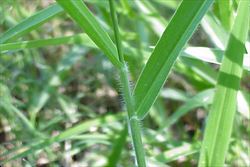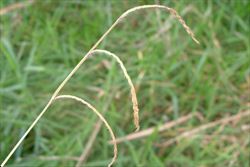Click on images to enlarge

infestation (Photo: Sheldon Navie)

habit (Photo: Sheldon Navie)

habit (Photo: Sheldon Navie)

leaves (Photo: Sheldon Navie)

close-up of leaf sheaths and leaf bases (Photo: Sheldon Navie)

seed-head (Photo: Sheldon Navie)

close-up of hairy flower spikelets (Photo: Sheldon Navie)

seed-head with immature fruit, note the slight extension of the stem (Photo: Sheldon Navie)

old seed-head after the seeds have been shed (Photo: Sheldon Navie)

young plant with stems initially spreading close to the ground (Photo: Sheldon Navie)
Scientific Name
Urochloa decumbens (Stapf) R. Webster
Synonyms
Brachiaria decumbens Stapf
Family
Gramineae (South Australia)Poaceae (Queensland, New South Wales, the ACT, Victoria, Tasmania, Western Australia and the Northern Territory)
Common Names
basilisk signal grass, brachiaria, signal grass, signalgrass, Surinam grass, Surinamgrass
Origin
Native to tropical eastern Africa (i.e. Kenya, Tanzania, Uganda, Burundi, Rwanda and Zaire).
Cultivation
This species has been widely cultivated as a pasture grass in the sub-tropical and tropical regions of Australia. The cultivar known as Urochloa decumbens 'Basilisk', which tends to be lower-growing and spread more via creeping stems (i.e. it is more stoloniferous), is widely planted.
Naturalised Distribution
Widely naturalised in northern and eastern Australia. It is most common in the coastal districts of Queensland and northern New South Wales, but is also naturalised in the northern parts of Western Australia and in some inland parts of Queensland.
Habitat
A weed of gardens, parks, roadsides, disturbed sites, waste areas, creek-banks (i.e. riparian areas), open woodlands and plantation crops (e.g. sugar cane) in sub-tropical and tropical regions.
Habit
A long-lived (i.e. perennial) grass with stems lying close to the ground at the base and then growing upright towards the tips (i.e. decumbent or ascending). The flowering stems grow 0.5-1.5 m tall but are usually less than 1 m in height. Plants may form a loose tuft and can also spread outwards via creeping stems (i.e. stolons).
Distinguishing Features
- a long-lived grass (up to 1.5 m tall) with stems usually lying close to the ground near their base and then turning upwards.
- its seed-heads have several branches and these are all arranged along one side of the stem.
- the seed-head branches have a loose covering of long hairs and are somewhat flattened.
- its oval-shaped flower spikelets are usually somewhat hairy.
- the tip of the stem usually extends slightly beyond the last branch of the seed-head.
Stems and Leaves
These stems often produce roots at the lower joints (i.e. at the basal nodes) and the flowering stems (i.e. culms) lie turn upward near their ends (i.e. they are decumbent or ascending).
The leaves consist of a sheath, that partially encloses the stem, and a spreading leaf blade. The leaf sheaths and stem joints (i.e. nodes) can be either hairless (i.e. glabrous) or hairy (i.e. pubescent). Where the leaf sheath meets the leaf blade there is a tiny line of hairs (i.e. a ciliated ligule). The leaf blades are narrow (i.e. broadly linear) to lance-shaped (i.e. lanceolate) with contracted bases and they taper to a point at the tip (i.e. they have acute apices). These leaf blades (5-25 cm long and 7-20 mm wide) can be hairless (i.e. glabrous) or have a few long, soft, hairs with wart-like bases (i.e. tuberculose hairs). The leaf margins are entire and the leaves are usually pale green or yellowish green when growing in a sunny position.
Flowers and Fruit
The seed-heads (i.e. inflorescences) consist of 2-7 branchlets (i.e. racemes) that are arranged at the top of a stem (i.e. culm) reaching up to 1.5 m high. Each of the seed-head branches (i.e. racemes) is 1-6 cm long and bears numerous small flower spikelets in two rows. The seed-head branches themselves are somewhat flattened and usually have a loose covering of long hairs, and so do the flower spikelets. The main flower stalk usually extends slightly beyond the last seed-head branch (i.e. raceme). The flower spikelets (4-5 mm long) are oval (i.e. elliptic) in shape and consist of two greenish bracts (i.e. glumes) and two tiny flowers (i.e. florets). One of these florets only has male flower parts and does not produce a seed (i.e. it is sterile), while the other floret has both male and female flower parts (i.e. it is fertile). Each floret has two pale green or whitish bracts (i.e. a palea and a lemma) and three yellow stamens, and the fertile floret also has an ovary topped with a feathery two-branched stigma.
The seeds (i.e. grains or caryopses) are shaped like a tear-drop and remain hidden inside the flower spikelet. The flower spikelets turn brown or straw-coloured as they mature and are intact leaving only the bare branches behind on the seed-head (which often become somewhat curled).
Reproduction and Dispersal
This species reproduces by seed and also vegetatively via its creeping stems (i.e. stolons). The seeds may be dispersed by water and animals, and in contaminated agricultural produce (e.g. pasture seeds).
Environmental Impact
Signal grass (Urochloa decumbens) is regarded as an environmental weed in south-eastern Queensland, and was recently listed among the top 200 most invasive plants in this region. It vigorously colonises disturbed environments and forms dense stands in the understorey of open woodlands, along waterways and on floodplains.
This species has also been observed to colonise disturbed corridors that are created for powerlines and road networks in rainforests in the Wet Tropics World Heritage Area in northern Queensland. Where signal grass (Urochloa decumbens) occurred in these corridors, it was generally observed to dominate the site.
Legislation
Not declared or considered noxious by any state government authorities.
Similar Species
Signal grass (Urochloa decumbens) is very similar to St. Lucia grass (Urochloa brizantha) and sabi grass (Urochloa mosambicensis), and relatively similar to para grass (Urochloa mutica) and paspalum (Paspalum dilatatum). These species can be distinguished by the following differences:
- signal grass (Urochloa decumbens) has seed-heads with 2-7 branches (i.e. racemes) that are usually all arranged along one side of the flowering stem. The flowering stem is usually also slightly extended beyond the last branch of the seed-head. Its flower spikelets are arranged in two rows along the seed-head branches and are somewhat hairy (i.e. pubescent).
- St. Lucia grass (Urochloa brizantha) has seed-heads with 2-16 branches (i.e. racemes) that are usually all arranged along one side of the flowering stem. The flowering stem is usually also slightly extended beyond the last branch of the seed-head. Its flower spikelets are arranged in a single row along the seed-head branches and are hairless (i.e. glabrous).
- sabi grass (Urochloa mosambicensis ) has seed-heads with 3-7 branches (i.e. racemes) that are usually all arranged along both sides of the flowering stem. Its flower spikelets are arranged in two rows along the seed-head branches and are somewhat hairy (i.e. pubescent) with very pointed tips (i.e. they extended into a mucro).
- para grass (Urochloa mutica) has seed-heads with 5-20 branches (i.e. racemes) that are usually arranged around the flowering stem and become much smaller towards the tip of the stem. Its flower spikelets are irregularly arranged along the seed-head branches (i.e. they are not in distinct rows) and are hairless (i.e. glabrous).
- paspalum (Paspalum dilatatum) has seed-heads with 2-5 branches (i.e. racemes) that are usually alternately arranged along either side of the flowering stem. The flowering stem is usually not extended beyond the last branch of the seed-head. Its flower spikelets are arranged in two or four rows along the seed-head branches and are very hairy (i.e. densely pubescent).
This fact sheet has been updated thanks to the sponsorship of Sunshine Coast Council.

